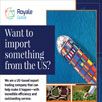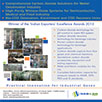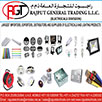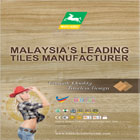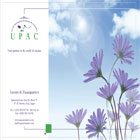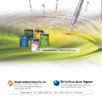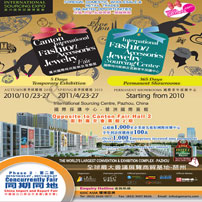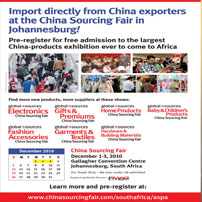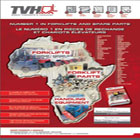

M a r k e t N e w s
Ethiopia: Industrial Parks Promoting Foreign Investment Influx,Tapering Unemployment
Posted on : Tuesday, 16th August 2016
Around the world, industrial parks have become significant vehicles for countries to provide competitive environments for industries to take off. Cognizant to this fact, the government of Ethiopia prioritized to the development of industrial parks to accelerate the economic transformation, promote and attract both domestic and foreign investors.
The Industrial Parks Development Corporation (IPDC) has built about ten industrial parks, and continue establishing the rest in some sectors across the country. In 2016, IPDC have been developing additional parks in Makalle, Dire Dawa, Kombolcha, Jima and Adama. Each park would cover a size ranging from 500 to 2000 hectares.
In fact, various scholars argue on the significance of industrial parks to contribute to the growth of a country's economy. With regard to its significance and pertinence, The Ethiopian Herald recently conducted exclusive interview with some industrial professionals from university, financial sector and manufacturing unit.
Dr. Atlaw Alemu from Department of Economics at AAU explained that as industrial parks are useful for processing exports, imports and managing duty free services, the system would simplify bureaucratic situations for manufacturers particularly for importing raw materials and exporting finished goods.
According to Dr. Atlaw, the most crucial use of industrial parks are increasing foreign direct investment, transferring technologies, creating linkages with international markets, and teaching locals on how to manage similar factories. To make use of these opportunities, he stressed that the infrastructures have to be fulfilled, particularly supplying energy and labour, developing work culture and reducing bureaucracy. In fact, many of the common facilities are particularly efficient if the firms are engaged in similar activities.
As foreign and domestic investors are continuing to work in close proximity, such closeness encourages not only co-operation but also fruitful sharing of technologies, special skills and ideas. Though most industrial parks tend to have a fairly heterogeneous mix of tenants, those engaged in similar activities can easily increase their production.
Clustering into industrial parks, small, medium and even large enterprises must take advantage of public infrastructures, and gain access to nearby skilled labour markets, research and educational facilities and other critical inputs. He, therefore, suggested that local enterprises need to enter into industrial parks based on their capacity, knowledge, and business plan.
Moreover, Dr. Atlaw commented that the government should also diversify complementary factories around industrial parks those producing metals, machines, spare parts, electrical products, other than specializing on same products.
In this sense, industrial parks also offer a valuable contribution to equitable and sustainable industrial development. They can also be considered as one of the most important factors supporting positive economic development bringing an integrated various functions into an industrial area with bulk of industrial production and services, as well as with high economy turnover and high employment.
Furthermore, Dr. Atlaw expressed that though the manufacturing sector contributes 5 per cent to GTP, the concern should be creating links with international buyers, and promote import substitutions. The interaction of international and domestic investors could create favourable conditions to facilitate purchasing, develop productive techniques.
The industrial parks have a range of common facilities such as recycling, waste collection, and effluent treatment, testing, standard quality control and heat treatment, refrigerated storage, even security services, recreation areas, health facility and post office.
The Hawassa Industrial Park (HIP) is a state of the art facility constructed at the cost of more than US 250 million dollar. It covers a land area of 1.3 million square meters, of which 300,000 metric square is factory shed built up area. It has additional area allocated for shared facilities such as dormitory and commercial buildings for the use of shopping centers, health clinics and banking services. Many industrial parks have also good rail and road transportation. When all factories in the park are fully operational, HIP will employ about 60,000 employees in two shifts.
On the other hand, EDE Garment and Textile Engineering PlC General Manager Eyasu Ermias said that the textile sector could not bring the anticipated outcome over the previous years due to scarcity of infrastructure. But currently, the government has been providing due attention to textile sectors, and making efforts in propelling textile based industrial parks like HIP.
According to Eyasu, industrial parks would be a solid ground to develop production capacity. "If we develop the capacity of our productivity, we can deliver the products needed by the global market," he said.
In addition, the textile sector has a considerable share to contribute for the country's vision of becoming middle income country by 2025. Eyasu added, "Since the government built such industrial parks, companies who have big share in the international market such as the Phillips-Van Heusen (PVH) Corporation - an American clothing company and Hennes & Mauritz (H & M) - a Swedish multinational retail-clothing company, entered this industrial park and began to produce textile products."
Thus, the participation of these international producers and buyers in HIP would increase the contribution of textile sector to hasten the growth of the national economy through holding the largest human power, transferring technology and increasing value additions.
It is obvious that industrial parks cannot be expected to bring immediate results, Eyasu says, the textile sector can be built on the progressive stage. As the companies could enter in the parks having international market standards, and they can add up knowledge and develop their capacity as a result. These cumulative knowledge would impart a competitive advantage in the country's economic growth.
Lastly, Development Bank of Ethiopia Senior Loan Officer Million Timer emphasized that though infrastructure was the determinant factor for the growth of industrialization, it is a big incentive and a capital for the country where the government set up industries and call for foreign investors to enter into production system.
Regarding the structure of industrial parks, Million commented that although foreign investors are important to increase Foreign Direct Investment, the participation of local investors in industrial park is very low. As it is the basis to industrialization, local investors genuinely need high support from the government. It is not enough to support local businesses in providing machineries and loans, they also need assistance in management intervention, he stated.
Moreover, infrastructure was the determinant factor to hold-back the growth of industrialization in the country. But, now the government provides big incentive to foreign investors such as preparing industrial parks and calling for them to begin production.
According to Million, reducing tax duties is not an incentive, it may help to reduce bureaucratic red tapes, and create conducive investment environment in the country to attract foreign investors. Of course, the foreign investment would assist to trim down unemployment, and increasing technology transfer.
Undoubtedly, industrial parks have a positive impact on businesses in a country and are beneficial if they are applying modern technologies and innovations in production processes, producing value added goods, supporting innovations and improving a research capacity of the country.
Ethiopia would profit from foreign companies entered in the park as they would bring economic and innovative potential to the country, and enhance modernization of industry. In sum, the expansion of industrial parks has significant contribution to increase the foreign currency, creating linkages to local products in internationally competitive markets.
Source : allafrica.com













